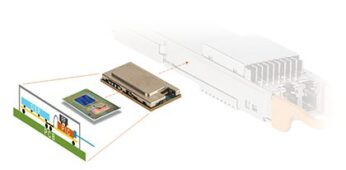The coherent blueprint to maximize network coverage, and the trend of coherent pluggables growth
Introduction
In Part 2 of this blog series, I discussed how the approach of common development based on silicon photonics (SiPh) benefits both performance-optimized multi-haul and MSA pluggable coherent products. In this blog, I expand on why the adoption of standardized baud rates to support Nx400GbE client traffic has been advantageous for MSA pluggable adoption as well as for maximizing multi-haul 400G network coverage in a service provider network. I also discuss how the growth in coherent pluggable shipments impacts the development of performance-optimized multi-haul coherent solutions.
Intuitive Coherent Classifications
With 400GbE becoming today’s unit of traffic currency, it is important to understand what coherent operating conditions are required to efficiently transport 400GbE client traffic. Prior generation leading-edge modulation technology for commercialization was at ~60-68Gbaud (Class 2), which utilized ~4 bits/symbol (~16QAM) modulation to support 1x400GbE client traffic over a 400G wavelength. We saw OIF 400ZR, OpenZR+ MSA, and Open ROADM adopt this transmission scheme for high-volume MSA pluggable applications. Performance-optimized multi-haul coherent solutions also leveraged Class 2 baud rates with dynamic transmission shaping that was centered at ~4 bits/symbol. In addition, multi-haul solutions supported higher capacity with 6 bits/symbol (~64QAM) for shorter reach DCI/Edge applications as well as maximum reach using 2 bits/symbol (~QPSK) for subsea applications. Multi-haul coherent DSPs can dial up or down the desired bits/symbol transmission within this dynamic range.
Moving to the next generation of coherent solutions, a similar approach is being followed to support Nx400GbE traffic per wavelength. In this case, leading edge ~120-136Gbaud Class 3 modulation technology can double the transport capacity compared to Class 2. With Class 3 technology, and using ~4 bits/symbol range, near complete coverage of a service provider’s network with 2x400GbE traffic (800G per wavelength line rate transmission) is possible, as discussed in a previous blog. By dialing the modulation bits/symbol down to ~2 bits/symbol, 1x400GbE subsea applications are possible, while dialing up to ~6 bits/symbol, 3x400GbE client traffic can be transported over a 1.2T wavelength for shorter reach DCI/Edge applications.
Figure 1 shows the number of supported 400GbE clients that can be transported over a single coherent wavelength as a function of baud rate class and ~2, ~4, and ~6 bits/symbol values.

Figure 1. Matrix showing the number of supported 400GbE clients that can be transported over a single coherent wavelength as a function of bits/symbol and baud rate class. Broad Nx400GbE network coverage becomes possible as we move to Class 3 baud rate implementations.
Figure 1 also illustrates how doubling the baud rate maintains the same network coverage (vis-à -vis reach) while doubling the capacity. With performance innovations, the coverage at this doubled capacity may even be greater than the previous class.
Implications of Shipment Trends
The good news is that the technology investments that went into supporting Class 2 coherent pluggable MSA solutions (green-shaded cell in Figure 1) are coming to fruition with high-volume shipments already occurring. In fact, Acacia recently announced over 50k port shipments of 400G coherent pluggable solutions. This is contributing to a notable transition: the number of pluggable coherent modules shipments is forecasted to exceed that of performance-optimized (embedded) coherent module shipments (Figure 2).
What are the implications of the growing adoption of MSA pluggable solutions? The overarching implication for coherent design evolution is that standardization/industry consensus (e.g., baud rates), design elements (e.g., high-speed electrical components), as well as materials and processes (e.g., silicon, SiPh, CMOS processes, co-packaging) that support high-volume MSA pluggable solutions all have a favorable impact on performance-optimized multi-haul solutions. In Part 2, I went into detail about how a common silicon platform enables a cycle of coherent development. The Figure 2 data below indicates that given this growth in MSA pluggable ports, we should see a greater beneficial impact to performance-optimized multi-haul designs because higher volume pluggable solutions can lead to better cost efficiencies, assuming both the multi-haul and MSA pluggable designs leverage a common technology platform.

Figure 2. LightCounting data showing the number of globally shipped MSA pluggable coherent ports exceeding the number of proprietary form-factor ports.
The Road Ahead for Multi-Haul Solutions—CIM 8
As the industry moves towards supporting higher transmission line rates, a natural path to higher steps in baud rate are becoming clearer. Doubling the Class 2 baud rates aligns with the Class 3 120Gbaud+ rates that are being standardized for transport of 800G client traffic. By leveraging common silicon processes and technology, performance-optimized solutions can benefit from the economies of scale.
The recently announced Acacia Coherent Interconnect Module 8 (CIM 8) powered by Acacia’s Jannu DSP are in line with this approach. The CIM 8 is a performance-optimized multi-haul solution that delivers industry-leading performance with single carrier 1.2T operation using 3D Siliconization packaging technology that includes the silicon photonics integrated circuit (SiPh PIC), high-speed modulator driver and transimpedance amplifier (TIA) in a single opto-electronic package. The miniaturization of the module components has resulted in a 140Gbaud multi-haul module design capable of faceplate pluggability.

Figure 3. Acacia’s Coherent Interconnect Module 8 is designed to incorporate many aspects of technology leveraged from higher-volume products (e.g., SiPh, processes, components, packaging).
The CIM 8 can provide efficient transport of 400GbE client traffic across the entire network, including 90 percent coverage using 800G (2x400GbE client traffic), corresponding to the Class 3 row in Figure 1.
All Roads Lead to Multi-Haul

Figure 4. By utilizing common silicon technology, Acacia can leverage the advantages of volume and high-performance designs creating a generational development cycle, with advancements over time, that can result in cost efficiencies as well as time-to-market advantages.
Coherent solutions have evolved from long-distance applications at relatively moderate volumes and are now at a point in the road where shorter distance high-volume applications are driving a demand exceeding their long-distance counterparts. By leveraging standardized baud rates aligned with the corresponding bits/symbol modulation optimized for Nx400GbE, we can increase the overlap of silicon-based design and investments between high-volume MSA pluggable and performance-optimized multi-haul coherent solutions. This enhances the coherent cycle of development, resulting in multi-haul solutions benefiting from volume manufacturable designs while leveraging common technology, which are important for maintaining cost-efficiencies for network operators as bandwidth demand continues to grow.
Learn More About the Considerations Driving Next Generation Multi-Haul Solutions:


